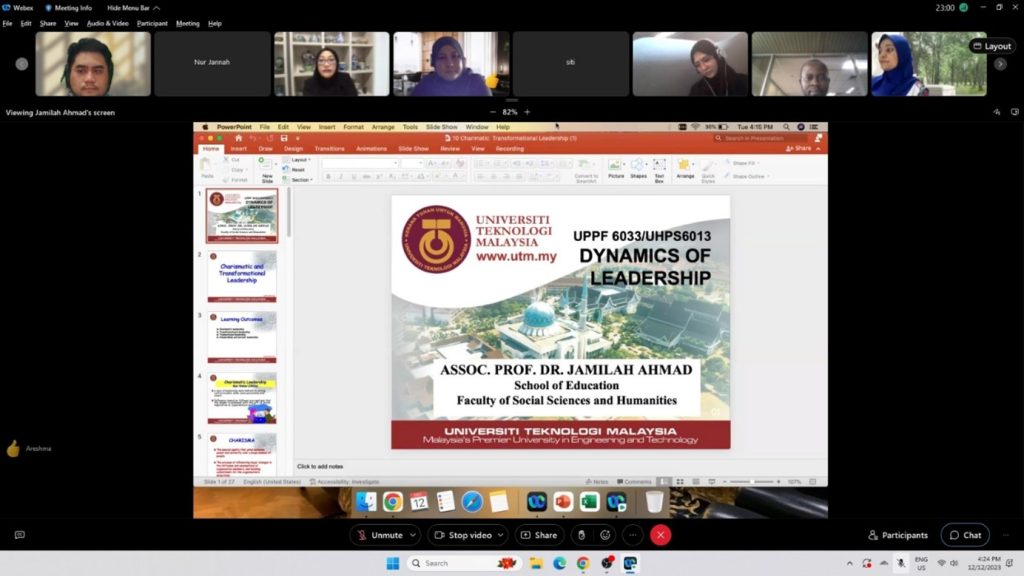Topic 10: Charismatic and Transformational Leadership
This week, I have learned about Charismatic and Transformational Leadership. First, Dr has reviewed e-learning regarding student engagement. There are students who have never opened e-learning. The Dr also checked the activities done by the students and found that there were students who did not complete them at all. Therefore, the Dr asked for an explanation from the student why he did not open and complete every activity that had been prepared.
This title has 4 learning outcomes, which will learn about charismatic leadership, Transformational leadership, Transactional leadership and Stewardship and servant leadership. Charismatic leadership is a type of leadership style defined by a strong communication skill, persuasiveness, and charm. Charisma is someone who has special quality on influencing people. We will feel calm when we see them.
Personal meaning in other words is identity. If we have a good personal meaning, we have a good identity that can influence people. Personal meaning can be achieved through self-concept, heritage, altruism, culture and tradition, political orientation, spirituality and religion, hobby pursuits and values. To be a charismatic leader you need to have 10 characteristics which are inspiring trust, high risk orientation, high energy action orientation, relationship power base, minimal internal conflict, empowering others, self-promotion, visionary, moral conviction, self-confidence and having verbal skills.
Next, there are 4 strategies to develop charismatic qualities, which are developing visionary skills, practicing a frank attitude, forming a humanitarian attitude, and forming an energetic personality. It must be practiced until it becomes a habit.
Then, there are two types of charismatic leaders. First is personalized which means pursuing goals driven by the leader and encouraging feelings of obedience, dependence, and submission in followers. Examples of personally charismatic leaders are Adolph Hitler and David Koresh. The other type is socialized which means pursuing organizationally driven goals and promoting feelings of empowerment, personal growth, and equal participation in followers. Examples of socially charismatic leaders are Martin Luther King Jr. and Theodore Roosevelt.
Dr asked the question whether Barack Obama is a charismatic leader? Many answered yes and the Dr wanted to hear an explanation as to why they answered yes. Arwa stated that Barack Obama is a charismatic leader because he is highly praised by the people and his country and has a very good character.
Next, I learned about transformational leadership by Bernard M Bass 1985. It is a leadership theory in which a leader works with followers to identify the changes needed, create a vision through inspiration, and implement the changes with a group of highly committed followers. There are four dimensions of transformational leadership. The first is ideal influence. Leaders engage in high standards of ethical behaviour. The second is intellectual stimulation. Leaders challenge assumptions, take risks and solicit ideas from followers and leaders recognize followers through stimulation, creativity, and innovation. The third is inspirational motivation. A leader articulates a compelling vision that inspires and motivates others to do beyond expectations. Lastly is individual consideration. A leader provides support and empathy to each person’s situation and background.
Then, I learned about transactional leadership by Max Weber 1947. Transactional leadership is based on a system of rewards and punishments with a strong focus on results and consists of a clear exchange between the leader and employees. It is also a framework of rules and guidelines setting the rewards or punishments that the worker will receive if he performs various actions that produce different outputs. There are three types of transactional leadership which are passive management by exception, active management by exception and contingent reward.
The last leadership studied was servant leadership by Robert K Greenleaf 1970. It is a leadership approach that places the service of others above all other priorities and focuses on creating an environment in which their team can thrive and accomplish their highest impact work.
After end of the learning delivered by Dr, the presentation activity continued by group 6 entitled the transformational leadership. This group consists of 5 members namely Ghirijaa, How, Suganniya, Liu and Venod. Venod was positive covid and we all wish would get well soon to him. Overall, the presentation was very interesting because they also provide a quizizz activity. In the end of presentation, we need to give mark to their group in the excel. Then, Dr asked Zana to present today due to sad news that she had last week.

